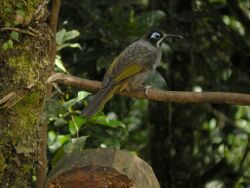Biology:Melidectes
| Melidectes | |
|---|---|

| |
| Belford's melidectes | |
| Scientific classification | |
| Domain: | Eukaryota |
| Kingdom: | Animalia |
| Phylum: | Chordata |
| Class: | Aves |
| Order: | Passeriformes |
| Family: | Meliphagidae |
| Genus: | Melidectes P.L. Sclater, 1874 |
| Type species | |
| Melidectes torquatus[1] Sclater, 1874
| |
Melidectes is a genus of bird in the honeyeater family Meliphagidae. All six species are endemic to New Guinea. The generic name is derived from the Greek meli for honey and dektes for beggar or receiver.[2]
Description
They are medium-sized honeyeaters, varied in appearance but possessing a long and sometimes stout bill and bare patch around the eye which is quite large and brightly coloured in some species.
Habitat
The genus is overwhelmingly restricted to montane environments. They occupy mountain forest, forest edge, alpine shrubland and shrubby thickets in grasslands.[3] In some instances where two species occupy similar ranges, for example the Belford's melidectes and the yellow-browed melidectes in the Schrader Ranges, the two species exclude each other and occur at different attitudes.[3]
Feeding
The diet of the melidectes is not known for all species, but for those that are known it consists of insects, nectar, pollen, fruit and berries. The short-bearded melidectes has also been recorded eating seeds. They feed in all levels of the forest, and in shrubs and thickets in more open environments. Some have been recorded feeding on the ground, either on ground plants or picking through the leaf-litter. They usually feed as singles, also foraging in pairs or small groups.[3] Like many honeyeaters they may be aggressive towards other birds, including berrypeckers, painted berrypeckers, other honeyeaters and even other members of the genus. One study found that the Belford's melidectes aggressively defended the flowers of the terrestrial root parasite Mitrastemmaa from the ornate melidectes.[4]
Status and conservation
Many of the species of melidectes are restricted range species, occupying small global ranges; in many cases single mountain ranges. The most widespread species, the ornate melidectes, has actually benefited from human activities. That species prefers forest edge, secondary growth and gardens, and has apparently increased in numbers.[3]
Species
The genus contains the following six species:[5]
- Cinnamon-browed melidectes (Melidectes ochromelas)
- Vogelkop melidectes (Melidectes leucostephes)
- Yellow-browed melidectes (Melidectes rufocrissalis)
- Huon melidectes (Melidectes foersteri)
- Belford's melidectes (Melidectes belfordi)
- Ornate melidectes (Melidectes torquatus)
Three additional species were moved to the resurrected genus Melionyx based on the results of a molecular phylogenetic study published in 2019.[5][6]
References
- ↑ "Melaphagidae". The Trust for Avian Systematics. https://www.aviansystematics.org/4th-edition-checklist?viewfamilies=119.
- ↑ Jobling, James A. (1991). A Dictionary of Scientific Bird Names. Oxford: Oxford University Press. pp. 145. ISBN 0-19-854634-3. https://archive.org/details/dictionaryofscie0000jobl.
- ↑ 3.0 3.1 3.2 3.3 Higgins, P.J.; Christidis, L.; Ford, H.A. (2008). "Family Meliphagidae (Honeyeaters)". in Josep, del Hoyo; Andrew, Elliott; David, Christie. Handbook of the Birds of the World. Volume 13, Penduline-tits to Shrikes. Barcelona: Lynx Edicions. pp. 611–615. ISBN 978-84-96553-45-3.
- ↑ Beehler, Bruce M. (1994). "Canopy-Dwelling Honeyeater aggressively defends terrestrial nectar resource". Biotropica 26 (4): 459–461. doi:10.2307/2389240.
- ↑ 5.0 5.1 Gill, Frank; Donsker, David; Rasmussen, Pamela, eds (2020). "Honeyeaters". IOC World Bird List Version 10.1. International Ornithologists' Union. https://www.worldbirdnames.org/bow/honeyeaters/. Retrieved 22 February 2020.
- ↑ Andersen, M.J.; McCullough, J.M.; Friedman, N.R.; Peterson, A.T.; Moyle, R.G.; Joseph, L.; Nyári, A.S. (2019). "Ultraconserved elements resolve genus-level relationships in a major Australasian bird radiation (Aves: Meliphagidae)". Emu 119 (3): 218–232. doi:10.1080/01584197.2019.1595662.
Wikidata ☰ Q525293 entry
 |

